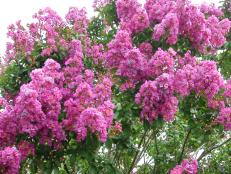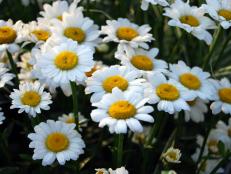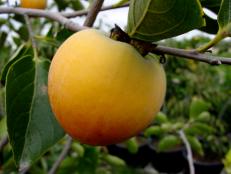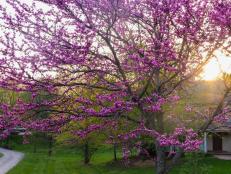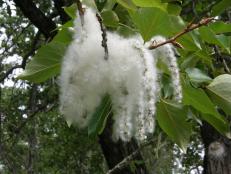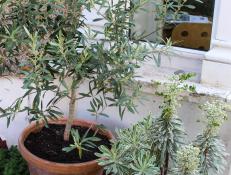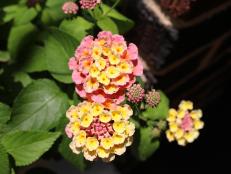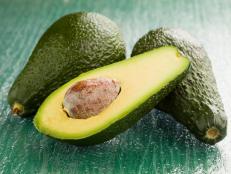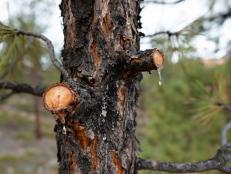Dogwood Tree Planting, Care, Varieties and Facts
Find out what you should know about dogwood trees, a four-season beauty and one of the most popular trees in America.

Dogwood trees are a favorite ornamental tree of homeowners — thanks to their modest size and four-season appeal. And once you know some facts about dogwoods, growing and nurturing these handsome trees is a breeze.
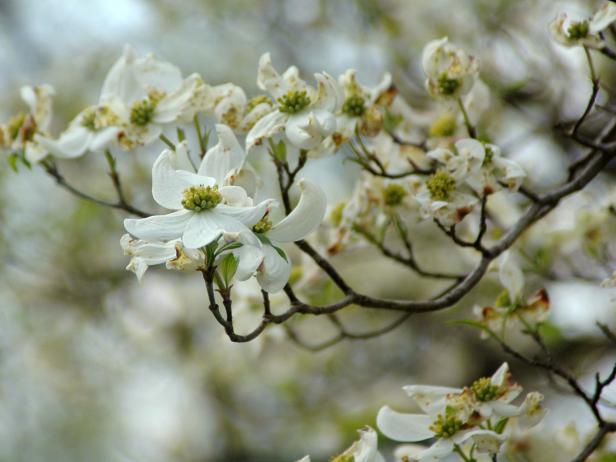
Photo By: Michele Lewellyn
In spring, dogwood trees explode with white (or sometimes pink or red) bracts centered with small clusters of yellow flowers.
In spring, these native trees (Cornus florida), which grow only to 20 to 30 feet, explode with white (or sometimes pink or red) bracts centered with small clusters of yellow flowers, shouting that winter is finally over. In summer, their blossoms give way to light green leaves that provide welcome shade. And in autumn, that foliage turns a stunning deep red before falling, leaving a handsome skeleton with alligator skin-like bark in winter.
Dogwood Tree Planting
Soil: Dogwoods prefer partial sun and nutrient-rich, well-drained soil.
Light: Because they grow in nature as understory trees, they prefer afternoon shade to shield them from blazing sunlight.
Fertilizer: If your garden soil is poorly drained, lacking in organic matter, or otherwise not all that great for dogwoods, it is crucial that you improve it. Dig a wide hole and add compost to the native soil – without overdoing it. Cover the area with a thick layer of natural tree leaf mulch to protect roots and "feed" the soil, and water deeply but not too often the first summer. Once established, dogwoods love a light feeding in the spring and a slow, deep soaking at least once a month during extremely dry summers.
Watering: Water your newly-planted dogwood tree until it is well-established and mulch to help your tree retain moisture. And because their roots are shallow, dogwoods benefit from extra water during periods of drought.
Pruning: Late fall or winter when the dogwood tree is dormant is the best time to prune. Most arborists recommend pruning dogwoods to improve their vigor and structure.
A Growing Secret
Horticulturists often add a special type of beneficial fungus to soils, to help roots grow better through a process called mycorrhiza. The naturally-occurring fungus colonizes plant roots and extends their “reach” by sometimes 20 or more times, while also helping reduce root diseases.
Wild dogwoods find these beneficial fungi quite easily in woodland soils, but home gardens — and the sterile potting soil in which nursery-grown trees are started — usually lack it. Adding it to your soil can have a dramatic effect on tree survival and growth.
You may be able to buy mycorrhizal fungi at a garden center or online, but it is easily found in the soil under wild dogwood. Find a tree that is growing well, dig up a little shallow dirt from underneath, and add it to the soil under your own tree to "inoculate" your tree roots.
Sounds weird, but it works — often just what the doctor ordered for any ailing trees.
Dogwood Tree Care: Disease and Pests
Aphids and powdery mildew can be a problem, but a fungicidal application and horticultural oils in spring can help prevent insects and diseases. Powdery mildew, an unsightly fungal infection, doesn't usually kill the tree but probably weakens it until another pest comes along and delivers the final blow.
Though not as severe a threat as it was several years ago, the dogwood anthracnose fungus can be prevented by planting trees where they receive morning sun and good air circulation.
Disease-Resistant Dogwoods
To increase your chances of enjoying a healthy dogwood, choose a cultivar with disease resistance to both anthracnose and powdery mildew; developed by Rutgers, the Stellar series, including 'Stellar Pink', 'Constellation', 'Celestial' and 'Aurora', show some resistance against anthracnose and powdery mildew and a high degree of resistance against dogwood borer. 'Appalachian Spring' is extremely resistant to anthracnose.
In the meantime, however, a better option might be the Kousa dogwood (Cornus kousa), which has better resistance to anthracnose and moderate resistance to powdery mildew. Unlike C. florida, Kousa dogwood "flowers" after the leaves appear, so you don't get that fairyland burst of white that's so welcome on an early spring day. But getting a leg up over two devastating diseases is pretty nice, too.
Flowering Dogwood Tree Varieties 14 Photos
These lovely dogwood tree varieties offer four-season garden beauty.
Dogwood Tree Facts
- The dogwood name is derived from "dagwood," which refers to the trees' earliest use as material for making daggers and swords.
- America's founding fathers were big dogwood fans. George Washington planted them at Mount Vernon and Thomas Jefferson at Monticello.
- Dogwoods are native to North America and are also native to Asia and Europe.
- Native Americans used the dogwood tree to make arrows, daggers and toothbrushes.
Flowering Trees for a Spring Show
Flowering Trees for Spring 10 Photos
Discover 10 gorgeous flowering trees including dogwood that will turn your yard into a springtime flower show.








